FORTUNE: Why Solar Developers Aren’t Happy with the Desert Renewable Energy Plan
The Desert Renewable Energy Conservation Plan, eight years in the making, was designed to streamline development of wind and solar projects on federal and private lands in California while preserving pristine desert habitats.
On Wednesday, the U.S. Department of Interior unveiled the first phase of the plan, covering 10.8 million acres of federal lands managed by the Bureau of Land Management. It designates 388,000 acres of those lands as best for renewable energy development. Applications for projects in those areas will receive a streamlined permitting process and possible financial incentives, the agency said in a press release.
LA TIMES: Interior Department signs blueprint for renewable energy development in the California desert
Projects proposed for Development Focus Areas would enjoy streamlined permitting. Energy development would also be possible on other lands, totaling more than 400,000 acres, but without streamlining. Increasing the amount of renewable energy produced on federal lands has been a key part of the Obama administration’s climate change policies, which seek to cut fossil fuel use and greenhouse gas emissions.
“You are the epicenter of that here in the Southern California desert,” Interior Secretary Sally Jewell told federal, state, local and tribal officials who had gathered at a signing ceremony in Palm Desert. “We’ve all come together in a way that is a path forward for the rest of the nation.”
WASHINGTON POST: The government just decided the future of California’s desert, and solar companies aren’t happy
And while the decision by the Bureau of Land Management largely satisfied some stakeholders — particularly conservationists who have been battling to protect iconic species that inhabit this ecosystem like the desert tortoise and bighorn sheep — clean energy interests protested upon learning that only 388,000 acres would be explicitly set aside for renewable energy. That’s the same amount of area as in an earlier draft of the plan that these groups had strongly criticized.
About 6.57 million acres of a landscape that stretches from near Los Angeles all the way to the Arizona and Nevada borders will be set aside for conservation, with no development allowed, and a partially overlapping 3.595 million acres will be designated for recreational activities. There are an additional nearly 500,000 acres that, while not explicitly designated for clean energy, might also be used for this purpose, if applications are approved by the agency.
ABE NEWS: Plan Divvies up Desert for Conservation, Energy Projects
The tension between the renewable energy industry and conservation groups was highlighted in the development of the Ivanpah solar plant, which opened in 2014 on roughly 5 square miles (13 sq. kilometers) of federal land near the California-Nevada border.
An environmental group unsuccessfully sued the federal government in an attempt to stop construction that displaced desert tortoises. In the end, the developers spent more than $20 million to relocate the animals. The rush to the desert comes amid ambitious climate goals set by the federal government and the state.
California is on track to meet a state goal of having a third of its energy come from renewable sources by 2020. It recently set a higher bar to generate half of its electricity from the sun, wind or geothermal power by 2030.












Comments